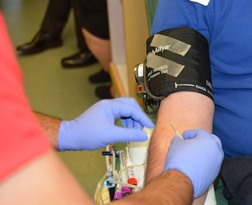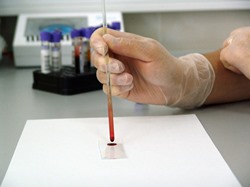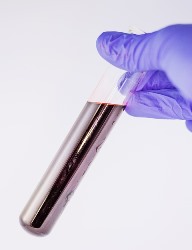Picking a Phlebotomist Course near Stanford Illinois
 Selecting the ideal phlebotomy school near Stanford IL is a critical first step toward a gratifying profession as a phlebotomist. It may seem like a challenging undertaking to analyze and compare all of the school alternatives that are accessible to you. Nevertheless it’s vital that you do your due diligence to make sure that you obtain a quality education. In fact, a large number of prospective students start the process by looking at 2 of the qualifiers that initially come to mind, which are cost and location. Another factor you may look into is whether to attend classes online or commute to a local campus. We’ll discuss more about online classes later in this article. What’s important to remember is that there is much more to comparing phlebotomy training programs than locating the cheapest or the closest one. Other factors including reputation and accreditation are also important considerations and must be part of your selection process also. To assist in that effort, we will supply a list of questions that you need to ask each of the phlebotomy schools you are assessing to help you choose the ideal one for you. But prior to doing that, let’s address what a phlebotomist is and does, and then resume our conversation about online schools.
Selecting the ideal phlebotomy school near Stanford IL is a critical first step toward a gratifying profession as a phlebotomist. It may seem like a challenging undertaking to analyze and compare all of the school alternatives that are accessible to you. Nevertheless it’s vital that you do your due diligence to make sure that you obtain a quality education. In fact, a large number of prospective students start the process by looking at 2 of the qualifiers that initially come to mind, which are cost and location. Another factor you may look into is whether to attend classes online or commute to a local campus. We’ll discuss more about online classes later in this article. What’s important to remember is that there is much more to comparing phlebotomy training programs than locating the cheapest or the closest one. Other factors including reputation and accreditation are also important considerations and must be part of your selection process also. To assist in that effort, we will supply a list of questions that you need to ask each of the phlebotomy schools you are assessing to help you choose the ideal one for you. But prior to doing that, let’s address what a phlebotomist is and does, and then resume our conversation about online schools.
[campusexplorer header_text=”Find Phlebotomy Schools Near You!” aos=”75346615″ concentration=”E7147EE5″ tracking=”PHL-CT”]
Phlebotomist Work Summary
 A phlebotomist, or phlebotomy technician, draws blood from patients. Although that is their principal responsibility, there is actually so much more to their job description. Prior to collecting a blood sample, a phlebotomist must confirm that the instruments being employed are single use only and sterile. After collection, the sample has to be properly labeled with the patient’s data. Next, paperwork has to be correctly completed in order to track the sample from the time of collection through the lab testing process. The phlebotomist then transports the blood to either an an outside lab facility or an in-house lab where it can be screened for such things as pregnancy, infectious diseases or blood type. Some Stanford IL phlebotomists actually work in laboratories and are accountable for ensuring that samples are tested correctly under the strictest quality control procedures. And if those weren’t enough duties, they can be required to train other phlebotomists in the drawing, transport and follow-up process.
A phlebotomist, or phlebotomy technician, draws blood from patients. Although that is their principal responsibility, there is actually so much more to their job description. Prior to collecting a blood sample, a phlebotomist must confirm that the instruments being employed are single use only and sterile. After collection, the sample has to be properly labeled with the patient’s data. Next, paperwork has to be correctly completed in order to track the sample from the time of collection through the lab testing process. The phlebotomist then transports the blood to either an an outside lab facility or an in-house lab where it can be screened for such things as pregnancy, infectious diseases or blood type. Some Stanford IL phlebotomists actually work in laboratories and are accountable for ensuring that samples are tested correctly under the strictest quality control procedures. And if those weren’t enough duties, they can be required to train other phlebotomists in the drawing, transport and follow-up process.
Where do Phlebotomy Techs Practice?
The most basic response is wherever there are patients. Their work places are many and varied, such as Stanford IL hospitals, medical clinics, long-term care facilities, or blood banks. They can be tasked to collect blood samples from patients of all ages, from babies or toddlers to senior citizens. A number of phlebotomy techs, based on their training and their practice, specialize in collecting samples from a specific kind of patient. For instance, those practicing in an assisted living facility or nursing home would exclusively be drawing blood from senior patients. If they are working in a maternity ward, they would be collecting blood from newborns and mothers solely. In contrast, phlebotomists practicing in a general hospital setting would be drawing samples from a wide variety of patients and would collect samples from different patients each day.
Phlebotomy Technician Training, Licensing and Certification
 There are essentially 2 types of programs that provide phlebotomy training in Stanford IL, which are certificate and degree programs. The certificate program usually takes under a year to finish and furnishes a basic education as well as the training on how to draw blood. It offers the quickest route to becoming a phlebotomy tech. An Associate of Science Degree in Clinical Laboratory Science, even though it’s not exclusively a phlebotomist degree, will incorporate training to become a phlebotomy tech. Offered at community and junior colleges, they typically require 2 years to complete. Bachelor’s Degrees are not as available and as a four year program offer a more extensive background in lab sciences. When you have completed your training, you will no doubt want to be certified. Although not required in most states, many employers look for certification before employing technicians. Some of the principal certifying agencies include:
There are essentially 2 types of programs that provide phlebotomy training in Stanford IL, which are certificate and degree programs. The certificate program usually takes under a year to finish and furnishes a basic education as well as the training on how to draw blood. It offers the quickest route to becoming a phlebotomy tech. An Associate of Science Degree in Clinical Laboratory Science, even though it’s not exclusively a phlebotomist degree, will incorporate training to become a phlebotomy tech. Offered at community and junior colleges, they typically require 2 years to complete. Bachelor’s Degrees are not as available and as a four year program offer a more extensive background in lab sciences. When you have completed your training, you will no doubt want to be certified. Although not required in most states, many employers look for certification before employing technicians. Some of the principal certifying agencies include:
- National Phlebotomy Association
- National Healthcareer Association (NHA)
- American Society for Clinical Pathology (ASCP)
- American Medical Technologists (AMT)
There are several states that do require certification prior to practicing as a phlebotomy tech, such as Nevada and California. California and a handful of additional states even require licensing. So it’s essential that you choose a phlebotomy training program that not only offers a premium education, but also prepares you for any certification or licensing examinations that you elect or are required to take.
Online Phlebotomist Colleges
 To start with, let’s resolve one potential misconception. You can’t obtain all of your phlebotomist training online. A significant portion of the course of study will be practical training and it will be carried out either in an approved Stanford IL healthcare facility or an on-campus lab|an on-campus lab or an approved healthcare facility}. Numerous courses also require completing an internship in order to graduate. However since the non-practical component of the training can be attended online, it can be a more practical option for many students. As an added benefit, many online programs are less expensive than their traditional counterparts. And some expenses, such as those for textbooks or commuting, may be minimized as well. Just confirm that the online phlebotomist program you select is accredited by a national or regional accrediting agency (more on accreditation to follow). With both the comprehensive online and clinical training, you can obtain a quality education with this method of learning. If you are dedicated enough to learn at home, then attaining your degree or certificate online may be the best choice for you.
To start with, let’s resolve one potential misconception. You can’t obtain all of your phlebotomist training online. A significant portion of the course of study will be practical training and it will be carried out either in an approved Stanford IL healthcare facility or an on-campus lab|an on-campus lab or an approved healthcare facility}. Numerous courses also require completing an internship in order to graduate. However since the non-practical component of the training can be attended online, it can be a more practical option for many students. As an added benefit, many online programs are less expensive than their traditional counterparts. And some expenses, such as those for textbooks or commuting, may be minimized as well. Just confirm that the online phlebotomist program you select is accredited by a national or regional accrediting agency (more on accreditation to follow). With both the comprehensive online and clinical training, you can obtain a quality education with this method of learning. If you are dedicated enough to learn at home, then attaining your degree or certificate online may be the best choice for you.
Topics to Ask Phlebotomist Programs
Now that you have a basic idea about what it takes to become a phlebotomy tech, it’s time to begin your due diligence process. You may have already selected the kind of program you wish to enroll in, whether it be for a degree or a certificate. As we previously mentioned, the location of the Illinois school is important as well as the tuition expense. Perhaps you have decided to enroll in an online phlebotomist college. Each of these decisions are an important part of the procedure for picking a program or school. But they are not the only considerations when arriving at your decision. Following are several questions that you should ask about all of the Stanford IL programs you are reviewing prior to making your ultimate selection.
Is the Phlebotomist Program Specific to Your State? As mentioned previously, each state has its own regulations for practicing as a phlebotomist. Some states require certification, while a few others require licensing. Each has its own requirement regarding the minimum amount of clinical training performed prior to practicing as a phlebotomist. As a result, you may have to pass a State Board, licensing or certification examination. Therefore it’s extremely important to choose a phlebotomy program that satisfies the state specific requirements for Illinois or the state where you will be working and preps you for any examinations you may be required to take.
Is the College Accredited? The phlebotomy program and school you select should be accredited by a highly regarded regional or national accrediting organization, such as the National Accrediting Agency for Clinical Laboratory Sciences (NAACLS). There are a number of benefits to graduating from an accredited program in addition to an assurance of a quality education. First, if your program has not received accreditation, you will not be able to sit for a certification examination offered by any of the previously listed certifying organizations. Next, accreditation will help in securing loans or financial assistance, which are typically not available for non-accredited schools in Stanford IL. Finally, earning a certificate or a degree from an accredited school can make you more attractive to prospective employers in the job market.
What is the College’s Ranking? In a number of states there is little or no regulation of phlebotomy schools, so there are some that are not of the highest caliber. So in addition to accreditation, it’s imperative to check the reputations of all colleges you are reviewing. You can begin by asking the schools for references from employers where they place their students as part of their job assistance program. You can screen online school reviews and rating services and ask the accrediting organizations for their reviews as well. You can also talk to several Stanford IL local hospitals or clinics that you might have an interest in working for and see if they can provide any insights. As a closing thought, you can check with the Illinois school licensing authority and find out if any complaints have been submitted or if the schools are in full compliance.
Is Enough Training Provided? First, check with the Illinois regulator or the state regulator where you will be working to learn if there are any minimum requirements for the length of training, both clinical and classroom. At a minimum, any Stanford IL phlebotomist program that you are considering should furnish at least 40 hours of classroom training (the majority require 120) and 120 hours of clinical training. Anything less than these minimums might signify that the program is not comprehensive enough to offer adequate training.
Are Internships Sponsored? Find out from the Illinois programs you are reviewing if they have an internship program in partnership with area healthcare facilities. They are the ideal means to obtain hands-on practical training often not available on campus. As an added benefit, internships can help students establish contacts within the local Stanford IL healthcare community. And they are a plus on resumes as well.
Is Job Placement Support Available? Landing your first phlebotomy position will be a lot easier with the assistance of a job placement program. Inquire if the colleges you are looking at offer assistance and what their job placement percentage is. If a school has a higher rate, meaning they place the majority of their students in positions, it’s an indication that the program has both a good reputation along with an extensive network of professional contacts within the Stanford IL health care community.
Are Classes Compatible With Your Schedule? Finally, it’s crucial to verify that the final program you pick offers classes at times that will accommodate your hectic lifestyle. This is especially true if you choose to continue working while going to college. If you can only go to classes at night or on weekends near Stanford IL, check that they are available at those times. Also, if you can only attend on a part-time basis, verify it is an option as well. And if you have decided to study online, with the practical training requirement, make certain those hours can also be completed within your schedule. And find out what the make-up policy is in case you need to miss any classes as a result of emergencies or illness.
Why Did You Desire to Become a Phlebotomy Tech?
When preparing to interview for a Phlebotomy Technician job, it's advantageous to review questions you might be asked. Among the questions that recruiters frequently ask Phlebotomy Tech applicants is "What drove you to pick Phlebotomy as a career?". What the interviewer is hoping to uncover is not merely the private reasons you may have for being Phlebotomy Tech, but additionally what characteristics and skills you have that make you outstanding at your profession. You will likely be asked questions relating specifically to Phlebotomy, along with a certain number of routine interview questions, so you need to organize a number of ideas about how you want to answer them. Considering there are numerous factors that go into selecting a career, you can respond to this fundamental question in a variety of ways. When formulating an answer, attempt to include the reasons the work appeals to you along with the abilities you have that make you an outstanding Phlebotomy Technician and the leading choice for the job. Don't make an effort to memorize an answer, but take down some concepts and talking points that pertain to your own experiences and strengths. Reading through sample answers can assist you to develop your own thoughts, and give you ideas of what to include to impress the interviewer.Find the Best Phlebotomist College near Stanford IL
Making sure that you choose the ideal phlebotomist training is an important first step toward your success in this rewarding health care career position. As we have addressed in this article, there are a number of factors that go into the selection of a quality school. Phlebotomist training programs are available in a variety of educational institutions, such as community or junior colleges, trade schools, and colleges and universities that provide a wide range of courses in medical care and health sciences. Program options may vary somewhat from state to state as each state has its own criteria when it comes to phlebotomy training, certification and licensing. The most critical point is that you must carefully evaluate and compare each school before making your final choice. By asking the questions that we have presented, you will be able to narrow down your choices so that you can pick the right college for you. And with the proper training, you can reach your goal of becoming a phlebotomist in Stanford IL.
Learn About Stanford Illinois
Stanford, Illinois
Stanford is a village in McLean County, Illinois, United States. The population was 596 at the 2010 census. It is part of the Bloomington–Normal Metropolitan Statistical Area.
Stanford was platted, under the name of Allin, on December 14, 1867. Its founder was John Armstrong (January 20, 1820 - August 7, 1912).[4] It was founded when the Jacksonville Division of the Chicago Alton and St. Louis Railroad was extended westward from Bloomington. The McLean County town of Covell was founded, within a few months of Allen, as a station on the same railroad. In 1870 the name of the town was changed to Stanford. It was incorporated as a village in June 1874. The town's founder, John Armstrong was born in Posey County, Indiana. He was first a farmer and then ran a grocery in Stanford, where he continued to live until his death in 1912. For many years after the town was founded John Armstrong ran a grocery in Stanford.[5]
The original town of what would soon become Stanford had an unusual "L" shaped design, with the leg of the "L" extending to the east along the railroad tracks. The large area in the crook of the "L" was not platted, but remained in the hands of John Armstrong, the town founder, whose residence was near the tracks on the north side of the railroad. Rather than a central square, the original plat of Stanford, like many towns laid out in the 1850s and 1860s, featured two rectangular public areas labeled as "Depot Grounds" which extended along either side of the tracks. The depot itself was on the north side of the tracks and, in 1874, the grain elevator on the south side.[6] As the town developed most businesses were located south of the tracks. By 1895 these included a hotel, a bank, the Masonic Hall, and several stores. Except for the depot, most of the railroad related facilities were on the Depot Ground south of the railroad. These included a stock yard, a Lumber yard, and several elevators. This area also held a band stand. There were two early churches in Stanford: the Christian Church on Boundary Street south of the business district and the Presbyterian Church in the southeastern part of town.[7]
According to the 2010 census, Stanford has a total area of 0.66 square miles (1.71 km2), all land.[8]
More Interesting Illinois Cities
Business Results 1 - 5 of 6
Stanford IL Blood Labs - BingNews Search results
-
Behind Enemy Lines: Five Questions for Stanford Cardinal On SI's Dylan Grausz
LOUISVILLE, Ky. - The Louisville football program is heading out west on the other side of their bye week, taking on ACC newcomer Stanford at The Farm. Ahead of the matchup, Louisville Cardinals On SI ...
-
Multiple Catalysts Ahead For Nektar Therapeutics
Nektar continues to make progress with rezpegaldesleukin, with results from phase 2 atopic dermatitis study expected in H1'25. Read my analysis of NKTR stock.
-
Trossen Robotics Launches Aloha Solo: Affordable and Portable Machine Learning Lab for Advanced Robotics Research
Trossen Robotics is proud to announce the release of the Aloha Solo, a powerful, all-in-one robotic machine-learning lab designed to meet the needs of advanced students, educators, and researchers at ...
-
Leaked emails reveal Project 2025 priorities for Stanford
In a recently leaked J.D. Vance email dossier, Daily reporters have uncovered Project 2025 plans to remake Stanford in a conservative image. Despite rumors of involvement by alumni like Peter ...
-
News Obituaries
SAN FRANCISCO (AP) — Philip G. Zimbardo, the psychologist behind the controversial “Stanford Prison Experiment” that was intended to examine the psychological experiences of imprisonment ...
-
Stanford psychologist behind the controversial "Stanford Prison Experiment" dies at 91
Philip G. Zimbardo, the psychologist behind the controversial "Stanford Prison Experiment" that was intended to examine the psychological experiences of imprisonment, has died. He was 91.
-
Psychologist behind the controversial ‘Stanford Prison Experiment’ dies at 91
Philip G. Zimbardo, the psychologist behind the controversial “Stanford Prison Experiment” that was intended to examine the psychological experiences of imprisonment, has died. He was 91.
-
Coach’s Notebook: Stanford football’s secondary running thin on depth, quarterback Elijah Brown soon to return
Stanford football will head into their Week 7 matchup with a banged-up secondary. Graduate safety Omari Porter and junior safety Jaivion Green will both be unavailable. Sophomore cornerback Aaron ...
-
The Best Lab-Grown Diamonds, According To A Gem Expert
Even the best lab-grown diamonds can stir up a bit of skepticism in shoppers—and for good reason. You might wonder: How can anything concocted in a laboratory compare to what’s organically ...
-
Column: Can Stanford tell the difference between scientific fact and fiction? Its pandemic conference raises doubts
On Oct. 4, Stanford University’s newly minted president, Jonathan Levin, opened an on-campus conference about pandemic policies by expressing the hope that the proceedings would “bring ...



